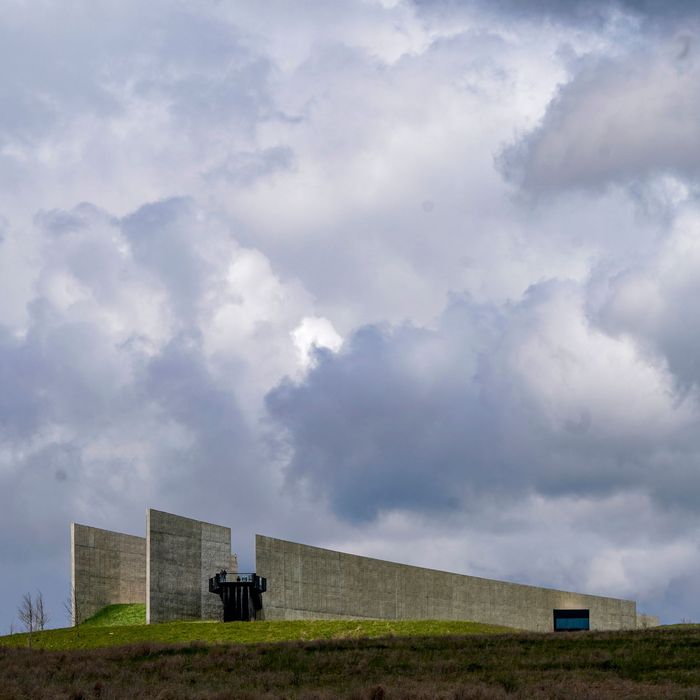
Paul Murdoch did not set out to heal the wound in the earth, but to preserve it as a scar. The architect of the Flight 93 National Memorial has spent most of the last two decades refining in meticulous detail his plans to honor the 40 people killed when Al Qaeda hijackers flew a passenger jet into an empty field in the Allegheny Mountains on September 11, 2001.
Of the four sites where terrorists used commercial airliners as missiles that morning, western Pennsylvania was, structurally, nothing like the others. It was remote and simple. There was no building that could fall. No masses to watch in horror or survivors to flee when the plane struck the ground at a speed of 580 miles per hour. But the terrorists had been aiming for Washington, D.C., where they intended to hit the White House or United States Capitol. They were stopped by passengers and crew members who, alerted to the attacks on the World Trade Center, stormed the front of the plane and forced it down 126 miles off target.
“It’s not that there weren’t heroic actions at the Pentagon or the World Trade Center. There were plenty of heroes,” Murdoch said. But the acts of heroism aboard Flight 93 were different, he added, “and I think that means that the expression of this memorial has to be different, has to be a bit more aspirational in its statement, not just about the absence of those people.”
The challenge of the memorial was to reflect the complexities of what happened — tragedy and triumph, life stolen and life protected in the same motion — as well as address the contradiction of the heavenly landscape with the evil of what unfolded here. Achieving this, Murdoch said, was not about having some kind of grand vision, or ideas for a highbrow statement. This was a delicate art, much more about showing than telling, and it called for hyper-perceptiveness, for humility, and for sensitivity. Style was a means through which to communicate what nature and the facts of the case had to say. But it wasn’t the point. What he designed is an honest place, not a sentimental one. Everything he needed was already here, in the information provided by the people onboard Flight 93, documented in phone calls to loved ones and in audio from the black box, and by the environment into which they crashed.
A few days before the 20th anniversary of the 9/11 attacks, I drove from Washington to Shanksville to tour the memorial with Murdoch. A few miles up the road and in between thunderstorms, sun pierced the clouds and landed on fields of slick grass and wildflowers, and on the leaves of the hemlock and aspen trees, setting them aglow like stained glass. The friction of awe and horror is often part of the experience of a memorial. Molly Ivins once wrote, of the Vietnam War Memorial, “It is terrible there in the peace and the pale sunshine.” I registered the beauty around me and I felt sick.
In deference to the range of emotions it is possible to feel here, Murdoch said he wanted to build something abstract enough to provide people with room to think. “You could do a place that just perpetuates anger, or the terror or the fear,” he explained. “It’s very easy to reduce it to something that doesn’t allow a multiplicity of interpretations.”
“I believe that there needs to be a certain abstraction to the forms because they need to be accessible to a lot of different types of people, whereas if it’s something that’s very specific and figural, how many ways are there to interpret that?” The sparseness of his sculptures and structures, he said, is about keeping open the possibility of varied interpretations. “Space is important,” he said, “You need to be bold enough and simple and clear.”
Murdoch was standing beneath the Tower of Voices, a 93-foot Jenga tower that he describes as an instrument. From the first days of his work on this project, in 2005, he knew that he wanted to work sound into the memorial somehow, to acknowledge the power of the phone calls and voicemails from the passengers in the minutes before they waged their assault against the terrorists. Inside the beams of concrete, arranged like the branches of the hemlocks, are steel sails and 40 hollow cylinders that work like chimes.
“We had people that could simulate the sound [the tower would make] in a sound lab. We had people that could simulate the wind through computational fluid dynamics,” Murdoch said. They tested the instrument in the Arizona desert, with input from a team that included structural engineers, wind engineers, acoustics engineers, sea sailors, land sailors, a professor of music and tuning theory, and a wind-chime artist. He wanted to achieve harmony, as a tribute to the people who acted together that day, and dissonance, as an acknowledgement of their deaths.
The tower is also meant to be a “positive statement,” Murdoch explained, “in the sense that it is lifted up out of the field and presented to the sky and the wind and the sun, and that these voices project, I think, in a beautiful way.”
As we spoke, a pack of children on a field trip approached. They wore brown T-shirts that used the Twin Towers in a logo to depict the letter L. “Are you Mr. Murdoch?” a teacher, Jennifer Reno, asked. “I absolutely love your design. I’ve been teaching my kids about it.” Another teacher walked up and thanked Murdoch, too. They posed for a picture. Reno nodded in the direction of the children. They had made it up the slope to the tower. Some of them horsed around, as kids do. And some of them stood together, necks craned, staring up. “It’s a little more difficult when they weren’t around,” Reno commented.
As Murdoch seems to have intended, it is possible to view the five square miles of this national park as a tool for education as well as a monument to heroism, or a mourning place for the families of the fallen, or a marker of the beginning of the war that we’ve been told has just ended. On a pane of glass that overlooks the field where a boulder symbolizes the crash, it’s described like this: “A common field one day. A field of honor forever.”
More on 9/11: 20 years later
- The Great Maritime Rescue of Lower Manhattan on 9/11
- The Woman in White
- 9/11 and the Rise of the (Unionized) Security Officer
































